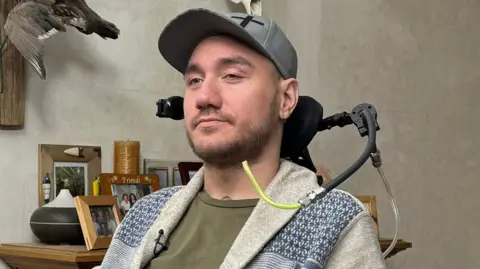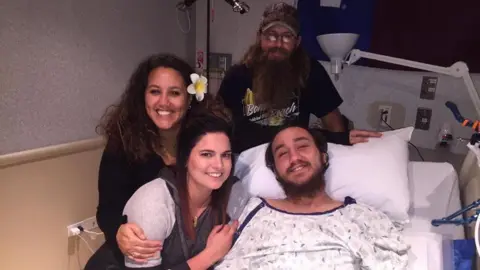BBC Information
 BBC
BBCHaving a chip in your mind that may translate your ideas into laptop instructions could sound like science fiction – however it’s a actuality for Noland Arbaugh.
In January 2024 – eight years after he was paralysed – the 30-year-old grew to become the primary individual to get such a tool from the US neurotechnology agency, Neuralink.
It was not the primary such chip – a handful of different corporations have additionally developed and implanted them – however Noland’s inevitably attracts extra consideration due to Neuralink’s founder: Elon Musk.
However Noland says the necessary factor is neither him nor Musk – however the science.
He informed the BBC he knew the dangers of what he was doing – however “good or unhealthy, no matter could also be, I’d be serving to”.
“If all the pieces labored out, then I may assist being a participant of Neuralink,” he mentioned.
“If one thing horrible occurred, I knew they might study from it.”
‘No management, no privateness’
Noland, who’s from Arizona, was paralysed under the shoulders in a diving accident in 2016.
His accidents have been so extreme he feared he won’t be capable to research, work and even play video games once more.
“You simply don’t have any management, no privateness, and it is arduous,” he mentioned.
“You need to study that it’s important to depend on different individuals for all the pieces.”
The Neuralink chip appears to be like to revive a fraction of his earlier independence, by permitting him to regulate a pc along with his thoughts.
It’s what is named a mind laptop interface (BCI) – which works by detecting the tiny electrical impulses generated when people take into consideration transferring, and translating these into digital command, similar to transferring a cursor on a display screen.
It’s a advanced topic that scientists have been engaged on for a number of many years.
Inevitably, Elon Musk’s involvement within the area has catapulted the tech – and Noland Arbaugh – into the headlines.
It is helped Neuralink entice plenty of funding – in addition to scrutiny over the security and significance of what’s a particularly invasive process.
When Noland’s implant was introduced, specialists hailed it as a “important milestone”, whereas additionally cautioning that it will take time to essentially assess – particularly given Musk’s adeptness at “producing publicity for his firm.”
Musk was cagey in public on the time, merely writing in a social media publish: “Preliminary outcomes present promising neuron spike detection.”
In actuality, Noland mentioned, the billionaire – who he spoke to earlier than and after his surgical procedure – was way more optimistic.
“I feel he was simply as excited as I used to be to get began,” he mentioned.
Nonetheless, he stresses that Neuralink is about greater than its proprietor, and claims he doesn’t take into account it “an Elon Musk gadget”.
Whether or not the remainder of the world sees it that manner – particularly given his more and more controversial function within the US authorities – stays to be seen.
However there is no such thing as a questioning the impression the gadget has had on Noland’s life.
‘This should not be potential’

When Noland awoke from the surgical procedure which put in the gadget, he mentioned he was initially in a position to management a cursor on a display screen by eager about wiggling his fingers.
“Truthfully I did not know what to anticipate – it sounds so sci-fi,” he mentioned.
However after seeing his neurons spike on a display screen – all of the whereas surrounded by excited Neuralink workers – he mentioned “all of it type of sunk in” that he may management his laptop with simply his ideas.
And – even higher – over time his capability to make use of the implant has grown to the purpose he can now play chess and video video games.
“I grew up enjoying video games,” he mentioned – including it was one thing he “needed to let go of” when he grew to become disabled.
“Now I am beating my pals at video games, which actually should not be potential however it’s.”
Noland is a strong demonstration of the tech’s potential to alter lives – however there could also be drawbacks too.
“One of many principal issues is privateness,” mentioned Anil Seth, Professor of Neuroscience, College of Sussex.
“So if we’re exporting our mind exercise […] then we’re sort of permitting entry to not simply what we do however probably what we predict, what we imagine and what we really feel,” he informed the BBC.
“As soon as you have obtained entry to stuff inside your head, there actually is not any different barrier to non-public privateness left.”
However these aren’t considerations for Noland – as a substitute he needs to see the chips go additional when it comes to what they’ll do.
He informed the BBC he hoped the gadget may finally permit him to regulate his wheelchair, or perhaps a futuristic humanoid robotic.
Even with the tech in its present, extra restricted state, it hasn’t all been clean crusing although.
At one level, a difficulty with the gadget brought on him to lose management of his laptop altogether, when it partially disconnected from his mind.
“That was actually upsetting to say the least,” he mentioned.
“I did not know if I’d be capable to use Neuralink ever once more.”
The connection was repaired – and subsequently improved – when engineers adjusted the software program, but it surely highlighted a priority ceaselessly voiced by specialists over the know-how’s limitations.
Massive enterprise
Neuralink is only one of many corporations exploring how you can digitally faucet into our mind energy.
Synchron is one such agency, which says its Stentrode gadget geared toward serving to individuals with motor neurone illness requires a much less invasive surgical procedure to implant.
Quite than requiring open mind surgical procedure, it’s put in into an individual’s jugular vein of their neck, then moved as much as their mind via a blood vessel.
Like Neuralink, the gadget finally connects to the motor area of the mind.
“It picks up when somebody is considering of tapping or not tapping their finger,” mentioned chief know-how officer Riki Bannerjee.
“By having the ability to choose up these variations it may well create what we name a digital motor output.”
That output is then changed into laptop alerts, the place it’s at present being utilized by 10 individuals.
One such individual, who didn’t need his final identify for use, informed the BBC he was the primary individual on the earth to make use of the gadget with Apple’s Imaginative and prescient Professional headset.
Mark mentioned this has allowed him to nearly vacation in far-flung areas – from standing in waterfalls in Australia to strolling throughout mountains in New Zealand.
“I can see down the highway sooner or later a world the place this know-how may actually, actually make a distinction for somebody that has this or any paralysis,” he mentioned.
However for Noland there’s one caveat along with his Neuralink chip – he agreed to be a part of a research which put in it for six years, after which level the longer term is much less clear.
No matter occurs to him, he believes his expertise could also be merely scratching the floor of what would possibly sooner or later turn out to be a actuality.
“We all know so little in regards to the mind and that is permitting us to study a lot extra,” he mentioned.
Extra reporting by Yasmin Morgan-Griffiths.




